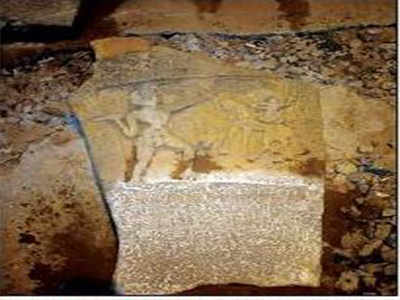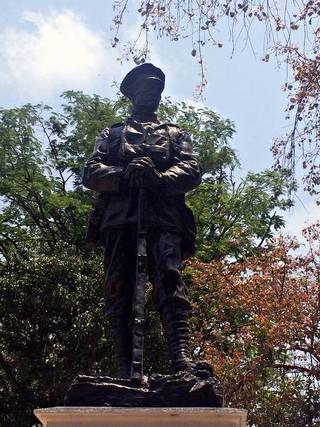Last month, I was at the iconic red-brick building of the Government Museum on Kasturba Road in Bengaluru behind which an exhibition called Inscription Stones of Bangalore was under way. On display were 28 large posters of inscription stones found in various parts of the city.
I had a task to do — ‘estampage’, a process of ‘lifting’ the inscriptions from the stone on to a piece of paper for a clearer read.
Royal writ
‘Estampage’ is a purely Indian term used by epigraphists, explained T.S. Ravishankar, former director of the Epigraphy branch of the Archaeological Survey of India. He had come to attend the show. The tablet I was working on was found just two months ago in a farm near Whitefield. The inscriptions were in Tamil. Another stone tablet in front of me was from Kattigenahalli, close to Yelahanka. It had inscriptions in old Kannada or Halegannada.

Aerospace engineer and history enthusiast Vinay Kumar is part of the citizen-led project, Bangalore Nagarada Shila Shasanagalu, which had organised the exhibition. According to Kumar, inscriptions like these are records of the city’s history, its culture, economic activity, regimes and language.
The inscriptions give a very good idea of the evolution of language. “From the second half of the 5th century, the inscriptions were in Halmidi, the oldest known form of the Kannada language,” said Ravishankar. The oldest existing Kannada inscription on a Veerakallu or ‘hero stone’ from Bengaluru dates back to about 750 CE.
It was found in Krishnarajapuram, a busy neighbourhood, as part of a temple compound’s wall. The inscription lay hidden under layers of paint. Constant exposure to heat from bonfires had caused the tablet to break into pieces. Fortunately, the part of the stone with the inscription survived and was shifted to the museum.
It read: “When Sripurusha Maharaja was ruling … Mareya … pierced and fell.” This refers to the Western Ganga dynasty ruler, Sripurusha, and the veera here is Mareya. The script is notable for the long, rectangle-shaped characters from the Ganga dynasty period. In some 600 years, these characters would evolve into the artistic, rounded characters of the Hoysala period.
Going, gone
For Kannada language fanatics, Kumar has a revelation. “The existing stone inscriptions on Kempe Gowda I (feudatory ruler under the Vijaynagara empire), who established the city of Bengaluru, are all in Telugu.” And inscription stones found within an area of 20-30 kilometres in the city are in Kannada, Tamil and Telugu.
The most celebrated inscription from Bengaluru is the one dating back to 890 CE and recording the death of Buttana Setti, son of Nagatara, in a battle in Bengaluru. It is one of the earliest instances of the mention of the city. The battle it talks of — the one between the Gangas, who were Jains, and the Nolambas, who were Shaivites — is significant, as it led to the decline of the Jain kings and the founding of a new line.
Recently, there has been another discovery of tablets with Tamil inscriptions in one of the city’s oldest temple, Madivala’s Sri Someshwara temple. Dated to 1247, the Chola period, they refer to ‘Vengalur’, the Tamil name for Bengaluru. Now historians believe that when Kempe Gowda established the city, he borrowed the name from a place that already existed in the 9th century.

Then there are records of the economic activity of the times. Imagine getting tax exemption for maintaining a neighbourhood lake. That is what an inscription found at Vibhutipura says about the king who waived taxes for residents who had constructed a tank in the area and maintained it.
One of the earliest mentions of women is of the daughter of King Nagatara, Thondabbe, who took a vow to fast until death after the battle of Bangalore. A stone tablet found in Hoskote shows a woman warrior fighting and dying on the battlefield.
About 150 such stone inscriptions of Bengaluru find a mention in Epigraphia Carnatica, a set of books on the epigraphy of the old Mysore region compiled by Benjamin Lewis Rice, the director of the Mysore Archaeological Department, between 1894 and 1905.
Of the stone inscriptions he documented, barely 30 remain.
Backup plan
Whenever Kumar and other enthusiasts like Dhanpal M. reach a site after consulting Epigraphia Carnatica, the local people usually talk of having seen the (now missing) stone as recently as a decade ago.
“Development!” Dhanpal laughed, “Everywhere they have ‘developed’ sites on which people build their homes without caring about these stones.”
Dhanpal is a BMTC bus driver who is passionate about the city’s history. He decided to scour Yelahanka, a Bengaluru suburb, for inscription stones. “Superstition is the main reason why in some places the stones remain untouched and in some other places are destroyed,” he said. For many, the myth that something untoward will happen to the person who reads the inscriptions is powerful enough to get the stones destroyed. There is also the belief that the inscriptions talk of hidden treasures. In the process of unearthing the ‘treasure’, the stones are often dug up and thrown away. Hero stones have a better chance of survival since they are worshipped.
Preserving the inscriptions is a challenge. The stones abandoned on roadsides and in dump yards can be cleaned and installed in safe locations close to where they were found.
This ensures that local people don’t lose their connect with the past as recorded in these stones. Shifting the inscriptions to museums is an option only when there is a real threat to their survival.
At the museum, I met Harish Pawaskar, a jeweller who started making 3D models of inscriptions using Reflectance Transformation Imaging technology. He showed me how to scan the QR codes on the printed posters with a smartphone.
This makes the 3D models pop up with details about the inscription. “By creating 3D models, we have all the information and details required to recreate any of the inscriptions physically in case anything gets destroyed in the future,” said Kumar, also a part of the project.
In a country notoriously indifferent to preservation, such projects are reassuring. More so for a city that seems quite intent on forgetting its past.
The freelance writer believes that everything has a story waiting to be told.
source: http://www.thehindu.com / The Hindu / Home> Society> Field Notes / by Jayanthi Madhukar / December 16, 2017












